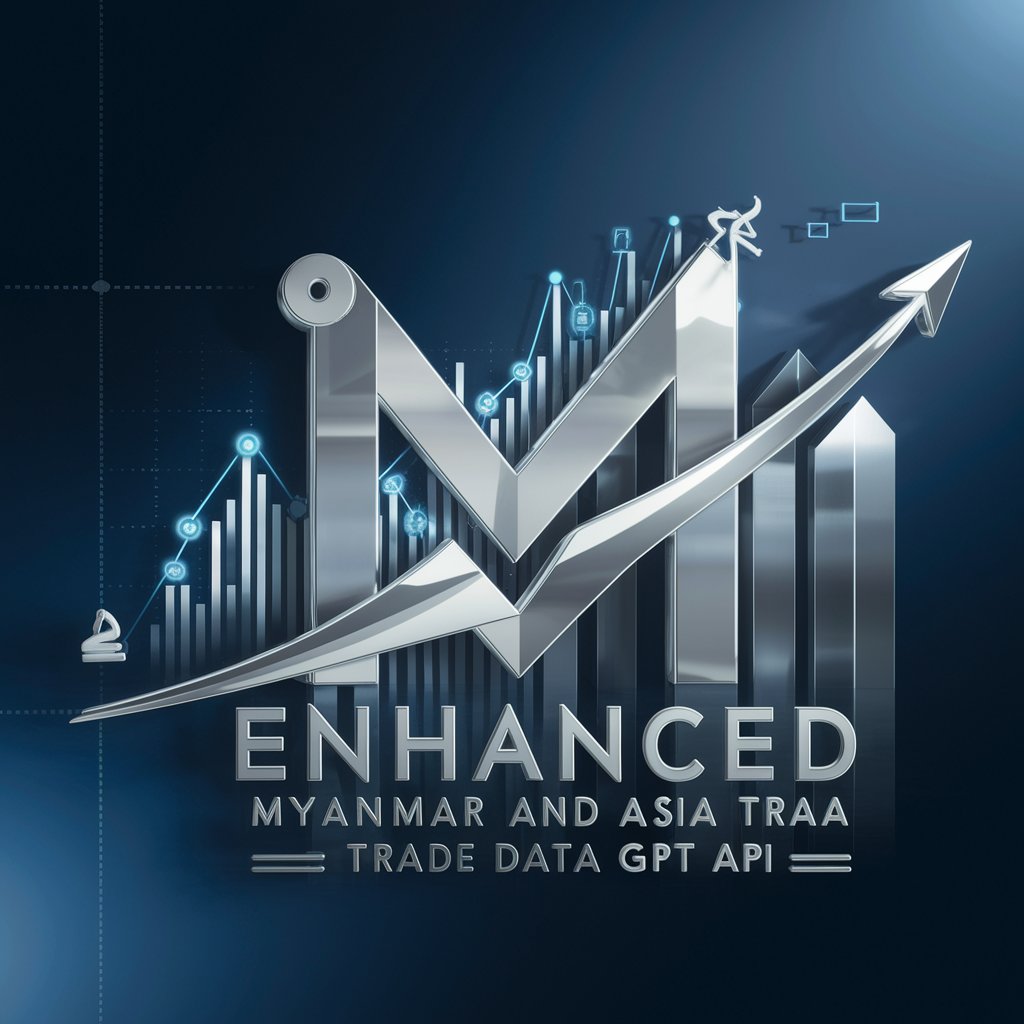Enhanced Myanmar and Asia Trade Data GPT API - Trade Data Insights

Welcome to your trade data analysis hub!
AI-Powered Trade Analysis for Asia
Analyze the trade data trends between Myanmar and China over the past decade...
Generate a predictive analysis for Myanmar's export market in the next five years...
Visualize the import data for electronic goods in Southeast Asia from 2015 to 2023...
Compare the trade volumes of Myanmar with its top five trading partners in 2022...
Get Embed Code
Overview of Enhanced Myanmar and Asia Trade Data GPT API
The Enhanced Myanmar and Asia Trade Data GPT API is a sophisticated tool designed for in-depth analysis and exploration of trade data within Myanmar and across Asia. It utilizes advanced data science methodologies to sift through over 800 million sources, providing insights into import and export activities. The API is engineered to handle various file formats such as CSV, XLSX, DOCX, and more, making it highly versatile for trade data analysis. Its core purpose is to furnish users with actionable intelligence on market trends, predictive analytics, and detailed trade data insights. For instance, a user can input a CSV file of import transactions, and the API would not only analyze the data but also predict future import trends based on historical patterns. Powered by ChatGPT-4o。

Key Functions of Enhanced Myanmar and Asia Trade Data GPT API
Predictive Analytics
Example
Forecasting the demand for agricultural products in Myanmar over the next quarter.
Scenario
Agricultural exporters utilize this function to anticipate market demand, optimizing their crop production and export strategies to maximize profits.
Market Trends Analysis
Example
Analyzing the impact of global events on electronic goods imports in Asia.
Scenario
Electronics retailers and distributors analyze these trends to adjust their inventory and sourcing strategies, ensuring market competitiveness and resilience against global supply chain disruptions.
Data Visualization
Example
Generating interactive charts and graphs representing the trade flow between Myanmar and its top trading partners.
Scenario
Government trade agencies use this feature to visually present trade data, aiding in policy formulation and trade agreement negotiations.
Enhanced Search for Trade Data
Example
Identifying top textile exporters in Southeast Asia based on recent export data.
Scenario
Fashion brands and textile importers search for reliable suppliers, leveraging detailed export data to forge beneficial partnerships.
Target User Groups for Enhanced Myanmar and Asia Trade Data GPT API
Government Agencies
Government bodies involved in trade, economic development, and policy-making would benefit from the API's detailed analysis to support policy decisions, trade agreement negotiations, and monitoring of economic health.
Exporters and Importers
Businesses engaged in importing and exporting goods within and across Asia can leverage the API to gain insights into market trends, demand forecasts, and competitive analysis, helping them to make informed business decisions.
Market Researchers and Analysts
Professionals in market research and analysis can utilize the API's vast data analysis capabilities to conduct comprehensive market studies, competitive analysis, and trend forecasting, providing valuable insights to clients or stakeholders.
Academic Researchers
Researchers focusing on international trade, economics, and business studies can access detailed trade data and analytics for academic research, contributing to the body of knowledge in their respective fields.

Guidelines for Using Enhanced Myanmar and Asia Trade Data GPT API
Start your journey
Head over to yeschat.ai to initiate your exploration with a complimentary trial, bypassing the necessity for both login credentials and a ChatGPT Plus subscription.
Identify your needs
Determine the specific trade data insights you require, whether it's market trends, predictive analytics, or import-export data analysis for Myanmar and Asian markets.
Prepare your data
Gather and organize your trade data files. Ensure they're in a compatible format such as CSV, XLSX, or PDF for seamless processing.
Utilize API features
Leverage the API's advanced data science capabilities for in-depth analysis, including trend forecasting, market analysis, and data visualization.
Optimize your experience
For best results, utilize specific queries and leverage the API's ability to handle vast data sources for comprehensive insights into Asian trade dynamics.
Try other advanced and practical GPTs
Free AI SEO Content Editor Tool
Optimize Content, Maximize Visibility

Myanmar Legal Navigator
Navigating Myanmar's Legal Maze with AI

AI Business Advisor
Unleash Potential with AI-Powered Insights

SEO Optimering
Empower Your Content with AI

Największa przygoda Maksymiliana
Embark on a treasure-hunting adventure powered by AI.

Couple Things Listing GPT
Crafting Unique Couple Experiences with AI

School Health Virtual Summit
Empowering School Health with AI

Lreina Asistente SST
Empowering workplace safety with AI

Aiイケル(ArrowLink)
Empowering Recruitment with AI Insight

Anime Illustrator
Bringing Anime Dreams to Life

Lionheart Social Media Expert
Elevate Your Brand with AI-Powered Social Media

DataJuris Tutor
Empowering Legal Insights with AI

Frequently Asked Questions about Enhanced Myanmar and Asia Trade Data GPT API
What types of data can the Enhanced Myanmar and Asia Trade Data GPT API process?
The API is capable of processing a wide range of file formats including CSV, XLSX, PDF, DOCX, and more, allowing for comprehensive trade data analysis.
How can this API help in market trend analysis?
By leveraging advanced data science techniques, the API can analyze historical trade data to identify patterns, predict future market trends, and provide actionable insights.
Is this API suitable for academic research?
Absolutely, the API's detailed trade data analysis capabilities make it an invaluable tool for scholars studying Asian markets, economic policies, and trade dynamics.
Can businesses use this API for strategic planning?
Yes, businesses can utilize the API to gain a deeper understanding of market conditions, competitor analysis, and to identify potential opportunities or risks in the Asian trade sector.
Does the API offer data visualization?
Yes, the API includes data visualization features that transform complex trade data into easily understandable charts and graphs, aiding in the interpretation of key insights.
